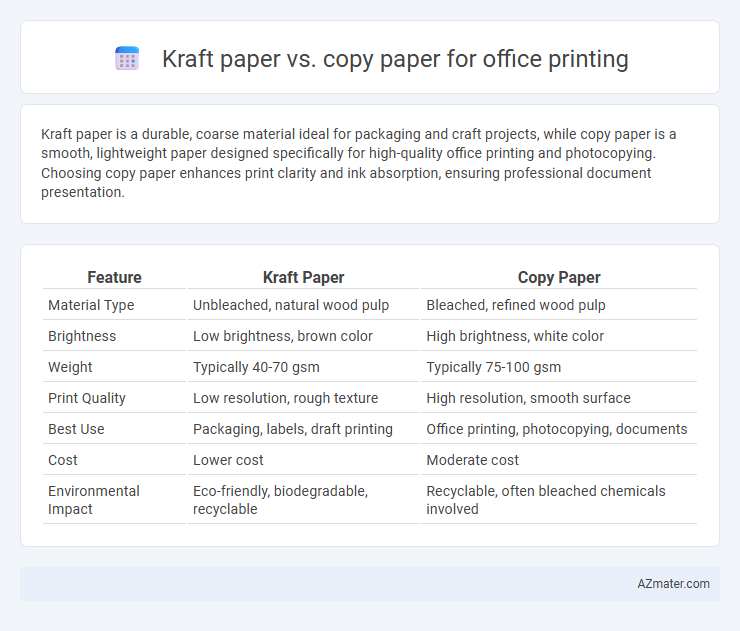Kraft paper is a durable, coarse material ideal for packaging and craft projects, while copy paper is a smooth, lightweight paper designed specifically for high-quality office printing and photocopying. Choosing copy paper enhances print clarity and ink absorption, ensuring professional document presentation.
Table of Comparison
| Feature | Kraft Paper | Copy Paper |
|---|---|---|
| Material Type | Unbleached, natural wood pulp | Bleached, refined wood pulp |
| Brightness | Low brightness, brown color | High brightness, white color |
| Weight | Typically 40-70 gsm | Typically 75-100 gsm |
| Print Quality | Low resolution, rough texture | High resolution, smooth surface |
| Best Use | Packaging, labels, draft printing | Office printing, photocopying, documents |
| Cost | Lower cost | Moderate cost |
| Environmental Impact | Eco-friendly, biodegradable, recyclable | Recyclable, often bleached chemicals involved |
Introduction to Kraft Paper and Copy Paper
Kraft paper is a durable, coarse paper made from wood pulp, commonly used for packaging, wrapping, and craft projects, offering high tear resistance and a natural brown color. Copy paper, typically smooth and white, is designed for everyday office printing and copying, ensuring clear text and crisp images with its fine texture and brightness. Choosing between Kraft paper and copy paper depends on whether strength and rustic appearance or print clarity and smoothness are the priority for office tasks.
Key Differences in Composition and Manufacturing
Kraft paper is made from chemical pulp processed using the kraft process, resulting in high-strength fibers that produce a thicker, more durable sheet ideal for packaging and heavy-duty applications. Copy paper, typically made from refined wood pulp using mechanical or chemical processes, is designed to be smooth, lightweight, and optimized for ink absorption and laser printing efficiency. The primary difference lies in Kraft paper's unbleached, coarse texture versus copy paper's refined, bleached surface, influencing their suitability for different office printing needs.
Print Quality: Kraft Paper vs Copy Paper
Kraft paper, made from coarse fibers, offers a rough texture that can cause ink to bleed and reduce print sharpness, making it less ideal for high-resolution office printing. Copy paper, designed for office printers, features a smooth surface and consistent weight, ensuring crisp, clear text and vibrant image reproduction. For detailed documents and professional-quality prints, copy paper provides superior print quality compared to kraft paper.
Paper Strength and Durability Comparison
Kraft paper exhibits superior paper strength and durability compared to standard copy paper, making it ideal for heavy-duty office printing tasks requiring resistance to tearing and wear. Its high cellulose content and coarse fibers provide enhanced tensile strength and durability, whereas copy paper, typically made from refined wood pulp, offers smoother texture but lower durability. For offices prioritizing long-lasting printed materials or packaging, kraft paper delivers a robust solution, whereas copy paper remains suitable for everyday document printing with moderate durability needs.
Cost-Effectiveness for Office Use
Kraft paper offers a cost-effective solution for bulk packaging and draft printing due to its lower price and durability compared to copy paper. Copy paper, while more expensive, provides superior print quality and smoothness essential for professional documents and presentations. Offices prioritizing budget savings with less emphasis on print clarity often prefer kraft paper for routine tasks, whereas high-quality copy paper remains the standard for official correspondence and reports.
Environmental Impact and Sustainability
Kraft paper, made from unbleached wood pulp, offers superior biodegradability and lower chemical processing compared to copy paper, making it a more environmentally sustainable choice for office printing. Copy paper, often bleached and treated with chemical additives, generates higher energy consumption and pollution during production, contributing to a larger carbon footprint. Choosing kraft paper reduces deforestation impact and promotes recycling efficiency, aligning with eco-friendly office initiatives and sustainable waste management practices.
Compatibility with Office Printers and Equipment
Kraft paper is generally compatible with most office printers but may require adjustments due to its thicker, coarser texture, which can cause feeding issues or smudging in inkjet and laser printers. Copy paper is specifically designed for office equipment, offering smooth surfaces and consistent thickness that ensure reliable feeding, clear print quality, and minimal wear on printer components. Selecting the appropriate paper type depends on printer specifications and the desired print quality, with copy paper being the standard choice for everyday office printing tasks.
Best Use Cases in Office Settings
Kraft paper is ideal for packaging, mailing envelopes, and printing draft documents where durability and strength matter, making it suitable for shipping departments and storage labeling. Copy paper excels in producing high-quality text documents, presentations, and general office printing tasks due to its smooth surface and brightness, ensuring sharp print clarity for everyday use. Offices benefit from using kraft paper for sturdier, rough-handling needs while relying on copy paper for professional, crisp paperwork and internal communications.
Aesthetic Appeal and Professional Presentation
Kraft paper offers a rustic, natural texture that enhances the tactile and visual appeal of printed materials, ideal for creative presentations or branding that emphasizes eco-friendliness. Copy paper provides a smooth, bright white surface that ensures sharp, clear text and images, maintaining a clean and professional look for standard office documents. Choosing between them depends on whether the priority is distinctive aesthetics or conventional professionalism in office printing.
Final Verdict: Choosing the Right Paper for Your Office
Kraft paper offers superior durability and strength, making it ideal for packaging and shipping documents, while copy paper provides a smooth, bright surface optimized for crisp text and vibrant color reproduction in everyday office printing. Selecting the right paper depends on the specific office tasks: copy paper suits high-volume printing and professional presentations, whereas kraft paper is better for heavy-duty uses and eco-friendly packaging needs. Balancing cost, performance, and purpose ensures that offices choose paper that enhances productivity and meets project requirements effectively.

Infographic: Kraft paper vs Copy paper for Office printing
 azmater.com
azmater.com